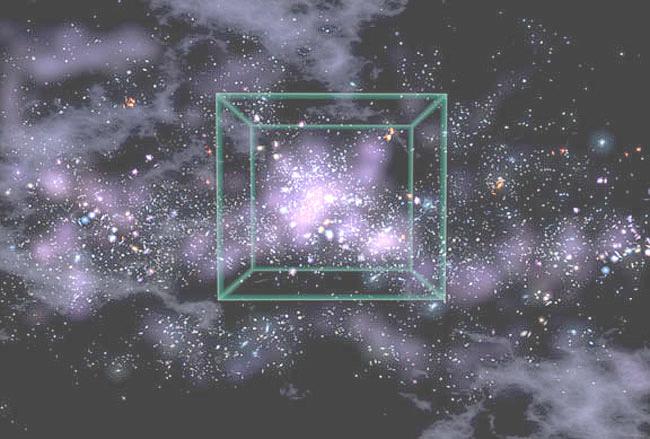Time Travel Research Center © 2005 Cetin BAL - GSM:+90 05366063183 - Turkey / Denizli
The Virgo Supercluster
 |
The Milky Way is a member of the Local Group of galaxies, which in turn is a part of the Virgo supercluster (see Figure 03-06). It is centered on the Virgo cluster and extends some 150 million ly across. The Virgo cluster itself contains thousands of galaxies including M87 , which is known to surround a gigantic black hole. Virgo's gravity affects the movement of its neighbors, including the Local Group. The supercluster is the last outpost before a space traveler would enter a nearly galaxy-free region called a cosmic void. Actaully, even the supercluster has a mass equaling some thousand trillion suns, virtually all its volume is empty in such a vast space. The Local Group of galaxies extends some 4 million ly across. Most galaxies in the group are considered dwarfs, but the two largest - the Milky Way and the Andromeda galaxy - are giant spirals. The galaxies of the Local Group are traveling together through space - indicating a common origin. |
Figure 03-06 Virgo Supercluster |
Formation of Superclusters
Recently in 1999, the X-ray telescope on the spacecraft Rosat has detected intergalactic wind blowing through superculsters. The observations showed the direction of the winds by the way they bent jets of electrified gases (plasma) emitted from the cores of galaxies (the same effect as bending smoke from a chimney). The wind directions were lined up with the galactic clusters within superclusters, i.e., along the supercluster axis. It seems to feed matter, including stars, galaxies and gas swept up and transported by the winds, into the growing galactic clusters.
| Formation of superclusters may be the next stage in a process that is shaping and forming fundamental units in the universe. It is believed that the process began after the Big Bang, when matter in the universe expanded out rapidly. Some matter clumped together to form stars. Then gravity took over and the stars formed galaxies, then groups, then clusters and, now, superclusters. The supercluster formation occurring now is at an early stage. These objects may be at the critical point of overcoming the random motion and are now collapsing under its own gravitation into an increasingly dense superstructure. Figure 03-07 is a computer simulation of the growth of large scale structure as matter is accreted along the filaments. Each square represents a step in the evolution of the universe. The sequence commences at redshift 10.0, less than 500 million years after the Big Bang, and terminates at redshift 0 corresponding to the current epoch. |
Density Fluctuations
| Most theories attribute the origin of large scale
structures to
quantum
fluctuation, which occurred near the beginning of Big Bang. The
fluctuation is subsequently enlarged by the
inflation and served as a blue-print for the large scale structures
such as the superclusters. Figure 03-08 depicts the supercluster
formation from quantum fluctuations. The dot at the top shows the actual
size, just at the end of inflation. An enlargement (about 300X) of a
small section of the universe at this time is shown in the middle.
Eventually, after about 14 billion years, the imprint has accumulated
enough matter and form the Coma supercluster today. In gravitational
terms, the superclusters are merely slight irregularities on a basically
smooth universe. It requires only one part in 100,000 of its rest-mass
energy to pull the structure apart. There is a problem with the formation of superclusters. Theory associates a characteristic time for the gravitational settling near the center of a clump. For a density fluctuation of 1.7%, it is of the order of 1 billion years; it would be 13 billion years for 0.3% fluctuation, etc. However, CMBR measurements imply a fluctuation of only 0.001%, which requires a settling time 1000 times longer than the age of the universe. The inconsistency can be resolved only if there is "dark matter" to enhance the fluctuation. |
Since dark matter interacts with normal matter only through gravity, the
pressure that kept the normal gas from collapsing coundn't act on it.
Particles of dark matter enjoyed an unimpeded assembly into large structures
(in the form of primordial fluctuation) long before the normal gas could
begin to get organized. By the time normal matter decoupled from the photons,
the dark matter had already grown into a primitive web-like network. As soon
as the normal matter lost its support from the photon pressure, the gravity
from the pre-existing dark matter structures quickly pulled normal gas into
the web. In this way, normal matter was given a gravitational "head start"
by dark matter.
Hiçbir yazı/ resim izinsiz olarak kullanılamaz!! Telif hakları uyarınca bu bir suçtur..! Tüm hakları Çetin BAL' a aittir. Kaynak gösterilmek şartıyla siteden alıntı yapılabilir.
The Time Machine Project © 2005 Cetin BAL - GSM:+90 05366063183 -Turkiye/Denizli
Ana Sayfa / İndex / Ziyaretçi
Defteri / ![]() E-Mail / Kuantum Fiziği / Quantum Teleportation-2
E-Mail / Kuantum Fiziği / Quantum Teleportation-2
Time Travel Technology / Kuantum Teleportation / Duyuru / UFO Technology
